BLOG
Most Meniscus Tears Don’t Need to be Fixed
As a society we are often sold quick fixes and overpromised results when it comes to recurrent pain. If you are watching a sporting event on TV start paying attention at how many commercials that pop up on the screen from copper fit to medications that depict the transformative effect these products have on the pain and disability that you are experiencing.
Oct. 17, 2022
Dr. Donald Mull, DC
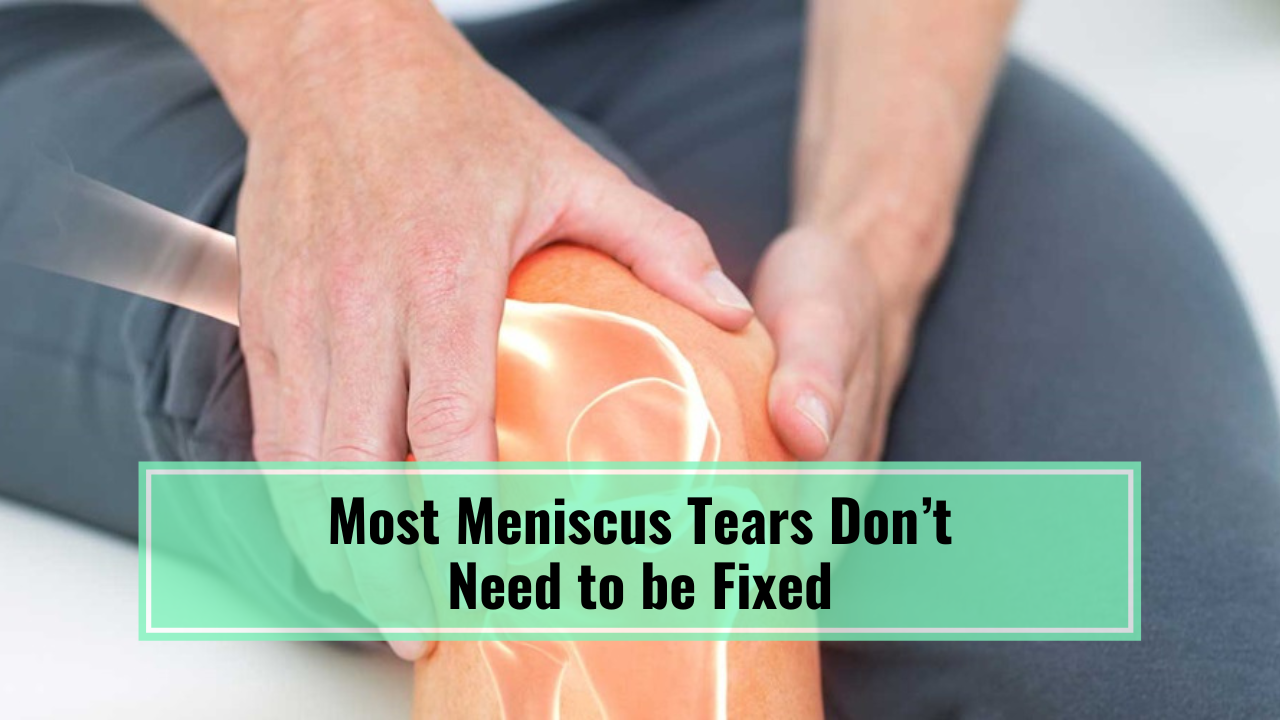
As a society we are often sold quick fixes and overpromised results when it comes to recurrent pain. If you are watching a sporting event on TV start paying attention at how many commercials that pop up on the screen from copper fit to medications that depict the transformative effect these products have on the pain and disability that you are experiencing.
The middle aged man playing catch with his son reaching down to rub his painful knee, visually distraught and concerned. Cue in the knee sleeve and his discomfort is gone and he is back to smiling and all fun and games with the kiddo. But what about those who don’t have this success? How are they supposed to feel? What are they to do?
Every time you have to bend down to one knee you notice a deep pain in your knee. You have begun to notice some more noises in your knee and any time you try to run the pain elevates. None of the tricks or medications as sold on TV or remedies given to by friends and family is working.
It is logical that the next step should be to consult with a doctor to get some help and guidance from an expert. This leads to receiving an x-ray that shows nothing and the knee pain is now forcing you to avoid some of the activities that may blow off some stress or spend time with loved ones.
With growing concerns, you want more answers. You seek out a specialist who then orders an MRI and FINALLY there is something to be seen! Your physician explains that you have a tear in your meniscus and explains the best course of action is a round of physical therapy. If this physical therapy is “successful” after 6-8 weeks than a surgery would be necessary.
You knew there was something “wrong” in there and if nothing else you at least don’t feel crazy. This new hope and positivity slowly starts to fizzle though, as you realize that your pain is still there despite taking out the running and all other “high impact” activities. Now not only are you in pain, but you are able to do LESS than before.
Stress has increased because you haven’t been able to be as physically active. You find you are more lethargic throughout the day, yet can’t sleep as well at night. 5 weeks in, your concern has returned in full force thinking the only option that is left is surgery.
At this point, let’s put a pause on this story; one of which we hear far too often. First let’s talk about what the meniscus is and what are some key points that many doctors are unfortunately not up-to-date on.
What is the Meniscus?
The meniscus is a lining of cartilage - a smooth, thick, rubbery tissue that rests between the shin bone and thigh bone. The medial or inside portion is shaped like a “C” and the outside portion is more of a “O” or oval shape.
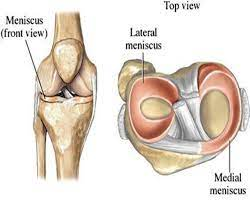
The meniscus, like many other tissues in the body, changes in appearance as we age. We used to think these changes were an indication of an injury which needed fixing. However, we know now that this relationship is not so clear (more on that later).
What does a Meniscus Tear Look Like?
There are a wide variety of different meniscus tears that are really classified by what they look like and the direction of the tear. Here are some of the different classifications that you may hear a physician tell you or read on an imaging report given to you.
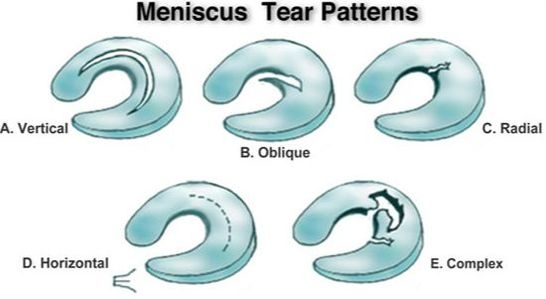
Looking at these it may seem a bit overwhelming and may be cause for a concern because after all if something is torn, it should be fixed right? Well, not exactly…
Not All Meniscus Tears Hurt
There are some people that walk around that have never experienced knee pain, yet have meniscus tears. For example, this study looked at 230 people with ZERO pain and found that 30 percent of them walked around with some sort of meniscus tear yet experience no discomfort, had no issues carrying out their daily life and lived happy and worry free (in regards to their knees at least).
Meniscus Tears Don’t Increase Risk of Pain
So people can have meniscus tears and experience no pain whatsoever. Okay fine, but if you do have a tear you must be more likely to have pain right? Well, no not necessarily.
Guermazi, et al showed in 2012that when you compare those with knee pain and without knee pain, the odds of anatomical changes (including meniscus tears) are almost identical. This is really telling and shows us that anatomical changes that we call tears, degeneration, bone spurs, etc is probably not the only driver of knee pain, frustration and disability.
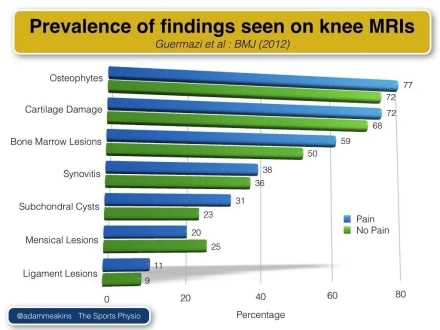
Meniscus Tear Does NOT Dictate Rehab
So now that we know that meniscus tears are more normal than we once thought before, it is important to understand that having an image of your knee is not the biggest driver on what is best for your rehab. Think about it this way, if you are an active individual that is young and has a very robust training experience, should you have the same rehab as someone who is much older, more stressed and doesn’t have any training background?
If you go to a place where you feel like you are receiving the same treatment as everyone else in the room, moving through the same stations and getting the same sheet of paper - you didn’t fail PT, PT fail you!
This picture is a phenomenal visual presentation of how even though two people have the same “diagnosis” they are two VERY different people. Your rehab should treat YOU as a person not your body part.
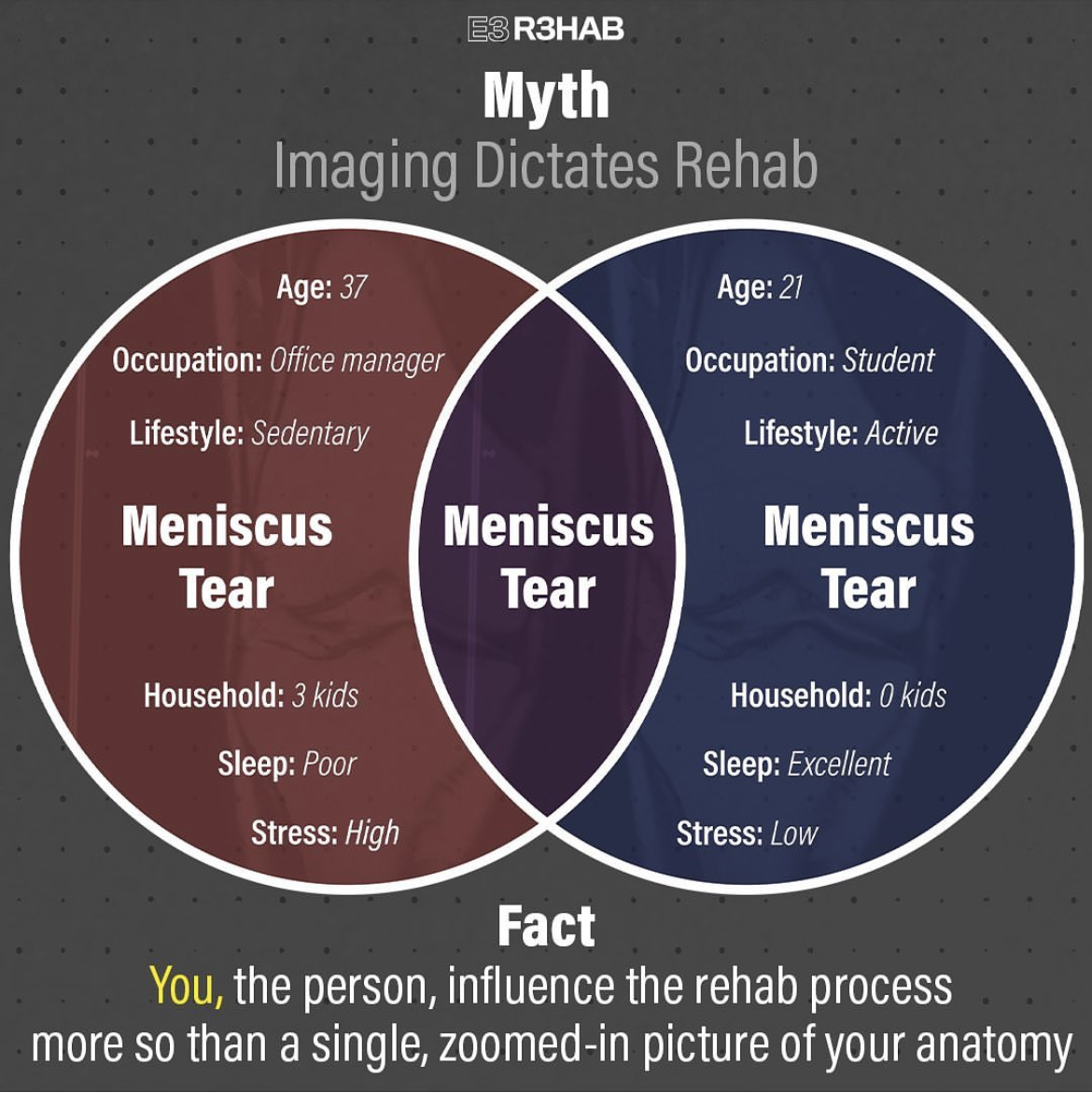
Surgeries are Not More Successful Than Non-surgical Options
Surgeries do make sense in some cases and can be helpful for some but I think they are often oversold. If the meniscus fragment is causing an obstruction in the joint line (most common being a bucket handle tear) and you notice that your knee is locking or giving out, surgery may be a good route and I would recommend seeking an orthopedic consultation.
However for more simple meniscus tears that do not involve the meniscus causing joint obstruction (which are far more common) the numbers will tell us that surgeries aren’t as successful as you’d assume.

Another important point from this is that knee pain does take time, especially if there wasn’t one fall or traumatic event that kickstarted the experience.
Now let�’s go back to where we were in the story and think about how this could be better understood and managed. If we know meniscus tears are relatively normal in people without any pain and meniscus tears do not increase risk of having pain while also knowing that surgery doesn’t outperform non-surgery - this can be very encouraging for one to resume activities that you love to do.
If the practitioner that is working with you treats you like an individual and really understands what you cannot currently do and what you would like to do in the future - you can find a starting place that you feel safe with. Over time you can build the capacity to do a little bit more and a little bit more with each small with giving a little bit more hope.
This over time allows you to FEEL how strong and capable your body can be doing the things that used to be a cause for concern. This is how I believe one should be helped and this is why we started Kinetic Impact. So we can treat everyone we see like family and teach them how to lift their physical limitations so they can train for the game!
Book your appointment hereif you are interested in working together and move without limitations.
Sources:
Related Posts
Foods to Avoid When in Pain
We often forget all of the factors that can influence pain. The easiest thing to do is to blame the last activity we have don...
Read more
Why Do My Muscles Feel Tight All the Time?
The goal here is to shed a little light on what's going on with your tight neck, tight back, tight anything really. This is ...
Read more
If Exercise is Painful, Should I Stop?
Many people (especially when recovering from an injury or in pain) believe that if they have pain during an exercise, it is d...
Read more
Search the Blog